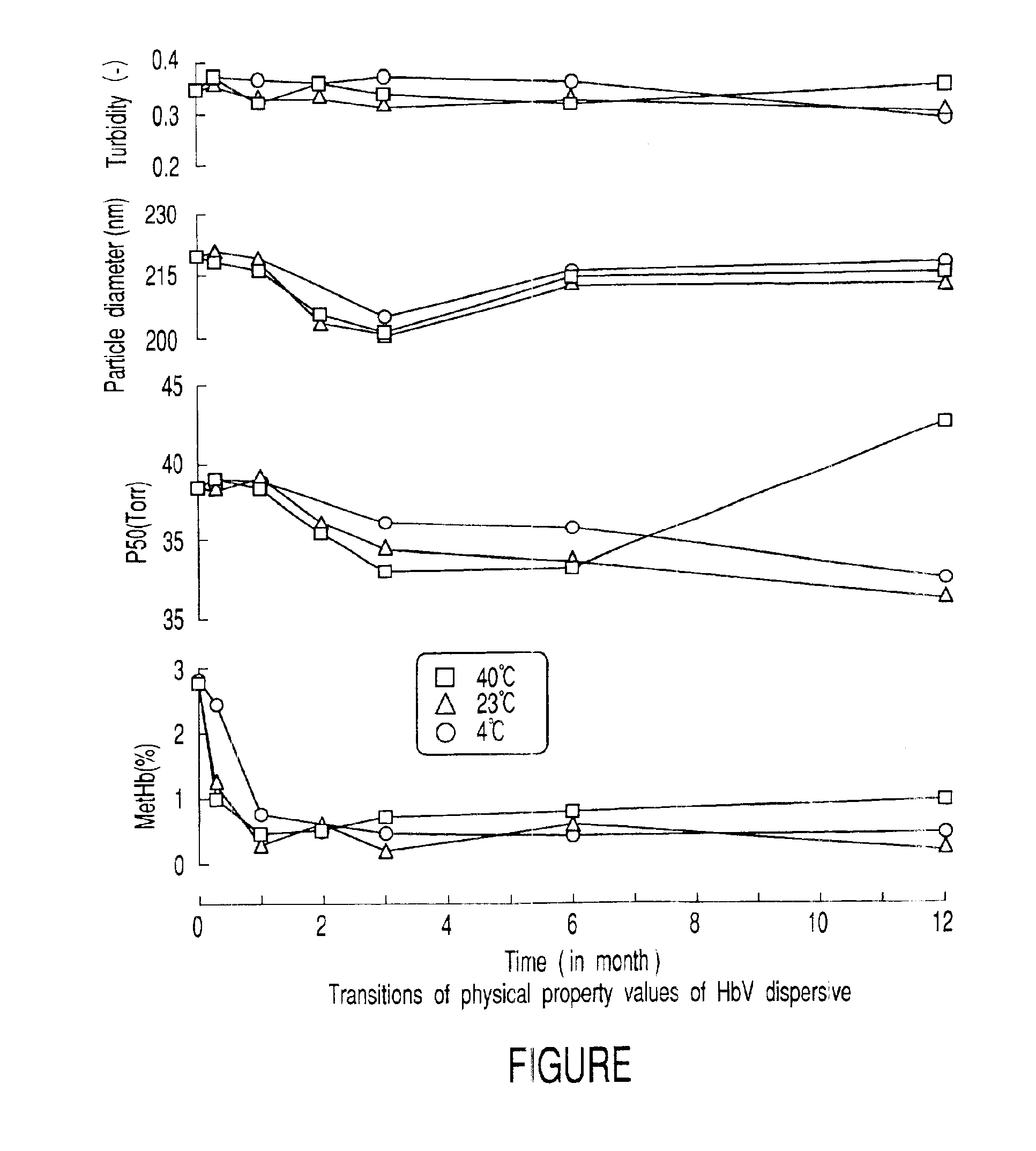Method of preserving oxygen infusions
a technology of oxygen infusion and oxygen storage, which is applied in the field of oxygen infusion preservation, can solve the problems of incompatibility between blood types, inadequate shelf life of erythrocytes, and various types of side effects, and achieve the effect of preserving oxygen infusion
- Summary
- Abstract
- Description
- Claims
- Application Information
AI Technical Summary
Benefits of technology
Problems solved by technology
Method used
Image
Examples
example 1
Pyridoxal 5′-phospholic acid was added to a high-purity stroma-free carbonyl hemoglobin (HbCO) solution (40 g / dL) obtained by purification of human erythrocytes such that the amount of Pyridoxal 5′-phospholic acid was 3 times molar excess of that of hemoglobin. Then, homocysteine was further added to the mixture to achieve a concentration of 5 mM, and then pH of the resultant mixture was adjusted to 7.4 with use of 1M-Na2CO3. The obtained mixture was filtrated through FM Microfilter (a product of FUJI FILM) having a pore diameter of 0.22 μm using Remolino (a product of Millipore), and a stock hemoglobin solution was obtained. After that, a mixed lipid powder, Presone PPG-I (a mixture of phosphatidylcholine / cholesterol / phosphatidylglycerol) was added to the solution little by little until the lipid concentration became 4.5% by weight, and then the resultant mixture was stirred at a temperature of 4° C. overnight, thus obtaining hemoglobin-containing multi-layered vesicles. With an ex...
example 2
A suspension of hemoglobin vesicles which are not modified with polyoxyethylene was prepared in a similar manner to that of Example 1, and the suspension was received in a vial and sealed therein. Then, a nitrogen gas, which was filtered with a sterile disk filter and saturated with water vapor, was introduced to the vial and was bubbled within the vesicle suspension in order to remove the dissolved oxygen completely. The oxygen partial pressure within the system was monitored by using Oxygen Partial Pressure Measuring Apparatus (Po2−100, a product of Inter Medicals), and it was observed that the oxygen partial pressure was decreased to 2 Torr. Thus, it was determined that with the above-described procedure, oxyhemoglobin was converted into deoxyhemoglobin.
The obtained oxygen infusion was subjected to preservation test. Preservation conditions used entailed preservation in a refrigerator (4° C.), room temperature preservation (23° C.), and preservation in an incubator (40° C.). The ...
example 3
A polyoxyethylene-modified hemoglobin vesicle suspension (molecular weight of polyoxyethylene: 2000) was prepared in a similar manner to that of Example 1. The obtained deoxy-form was transferred into an aluminum bag (Aluminized polyethylene bag, a product of GL Sciences, Inc.) under a nitrogen atmosphere, in order to isolate it from oxygen. The obtained infusion was preserved under conditions of preservation in a refrigerator (4° C.), room temperature preservation (23° C.), and preservation in an incubator (40° C.). With regard to each sample for these conditions, the same measurements as those of Example 1 were conducted for one year. The results obtained here were similar to those of Example 1.
PUM
| Property | Measurement | Unit |
|---|---|---|
| molecular weight | aaaaa | aaaaa |
| concentration | aaaaa | aaaaa |
| temperature | aaaaa | aaaaa |
Abstract
Description
Claims
Application Information
 Login to View More
Login to View More - R&D
- Intellectual Property
- Life Sciences
- Materials
- Tech Scout
- Unparalleled Data Quality
- Higher Quality Content
- 60% Fewer Hallucinations
Browse by: Latest US Patents, China's latest patents, Technical Efficacy Thesaurus, Application Domain, Technology Topic, Popular Technical Reports.
© 2025 PatSnap. All rights reserved.Legal|Privacy policy|Modern Slavery Act Transparency Statement|Sitemap|About US| Contact US: help@patsnap.com

